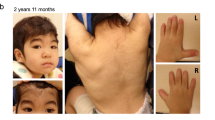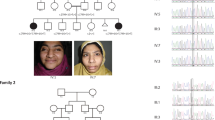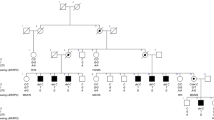Abstract
ADNP is a well-known gene implicated in intellectual disability and its molecular spectrum consists mainly in loss of function variant in the ADNP last and largest exon. Here, we report the first description of a patient with intellectual disability identified with an intragenic inversion in ADNP. RNAseq experiment showed a splice skipping of the inversed exons. Moreover, in-silico analysis of initiating ATGs in the mutated transcript using contextual Kozak score suggested that several initiating ATGs were likely used to translate poisonous out-of-frame ORFs and would lead to the suppression of any in-frame rescuing translation, thereby causing haploinsufficiency. As constitutive Alu sequences with high homology were identified at both breakpoints in reversed orientation in the reference genome, we hypothesized that Alu-mediated non-allelic-homologous recombination was responsible for this rearrangement. Therefore, as this inversion is not detectable by exome sequencing, this mechanism could be a potential underdiagnosed recurrent mutation in ADNP-related disorders.
This is a preview of subscription content, access via your institution
Access options
Subscribe to this journal
Receive 12 print issues and online access
$259.00 per year
only $21.58 per issue
Buy this article
- Purchase on Springer Link
- Instant access to full article PDF
Prices may be subject to local taxes which are calculated during checkout


Similar content being viewed by others
Data availability
The datasets generated during the current study are available from the corresponding author on reasonable request. This structural variant, NM_001282531.3(ADNP):c.-89-3923_201 + 2793inv, was submitted to the ClinVar database (SCV002820080). Variation ID: 1879783 Accession number: VCV001879783.1 URL:https://www.ncbi.nlm.nih.gov/clinvar/variation/1879783/?oq=SCV002820080&m=NM_001282531.3, (ADNP):c.-89-3923_201%202793inv.
References
Han JY, Lee IG. Genetic tests by next-generation sequencing in children with developmental delay and/or intellectual disability. Clin Exp Pediatr. 2019;63:195–202.
Binquet C, Lejeune C, Faivre L, Bouctot M, Asensio ML, Simon A, et al. Genome sequencing for genetics diagnosis of patients with intellectual disability: the DEFIDIAG study. Front Genet [Internet]. 2022;12:766964. https://www.frontiersin.org/article/10.3389/fgene.2021.766964.
Mandel S, Gozes I. Activity-dependent neuroprotective protein constitutes a novel element in the SWI/SNF chromatin remodeling complex. J Biol Chem. 2007;282:34448–56.
Sun X, Yu W, Li L, Sun Y. ADNP controls gene expression through local chromatin architecture by association with BRG1 and CHD4. Front Cell Dev Biol. 2020 ;8:553.
Sun X, Peng X, Cao Y, Zhou Y, Sun Y. ADNP promotes neural differentiation by modulating Wnt/β-catenin signaling. Nat Commun. 2020;11:2984.
Helsmoortel C, Vulto-van Silfhout AT, Coe BP, Vandeweyer G, Rooms L, van den Ende J, et al. A SWI/SNF-related autism syndrome caused by de novo mutations in ADNP. Nat Genet. 2014;46:380–4.
Breen MS, Garg P, Tang L, Mendonca D, Levy T, Barbosa M, et al. Episignatures stratifying Helsmoortel-Van Der Aa syndrome show modest correlation with phenotype. Am J Hum Genet. 2020;107:555–63.
Huynh MT, Boudry-Labis E, Massard A, Thuillier C, Delobel B, Duban-Bedu B, et al. A heterozygous microdeletion of 20q13.13 encompassing ADNP gene in a child with Helsmoortel–van der Aa syndrome. Eur J Hum Genet. 2018;26:1497–501.
Van Dijck A, Vulto-van Silfhout AT, Cappuyns E, van der Werf IM, Mancini GM, Tzschach A, et al. Clinical presentation of a complex neurodevelopmental disorder caused by mutations in ADNP. Biol Psychiatry. 2019;85:287–97.
Kent WJ, Sugnet CW, Furey TS, Roskin KM, Pringle TH, Zahler AM, et al. The human genome browser at UCSC. Genome Res. 2002;12:996–1006.
Gleason AC, Ghadge G, Chen J, Sonobe Y, Roos RP. Machine learning predicts translation initiation sites in neurologic diseases with nucleotide repeat expansions. PLoS One. 2022;17:e0256411.
Flynn JM, Hubley R, Goubert C, Rosen J, Clark AG, Feschotte C, et al. RepeatModeler2 for automated genomic discovery of transposable element families. Proc Natl Acad Sci. 2020;117:9451–7.
Altschul SF, Gish W, Miller W, Myers EW, Lipman DJ. Basic local alignment search tool. J Mol Biol. 1990;215:403–10.
Landrum MJ, Lee JM, Benson M, Brown GR, Chao C, Chitipiralla S, et al. ClinVar: improving access to variant interpretations and supporting evidence. Nucleic Acids Res. 2018;46:D1062–7.
Wright ES. Using DECIPHER v2.0 to analyze big biological sequence data in R. R J. 2016;8:352–9.
Stenson PD, Ball EV, Mort M, Phillips AD, Shiel JA, Thomas NST, et al. Human gene mutation database (HGMD®): 2003 update. Hum Mutat. 2003;21:577–81.
Karczewski KJ, Francioli LC, Tiao G, Cummings BB, Alföldi J, Wang Q, et al. The mutational constraint spectrum quantified from variation in 141,456 humans. Nature. 2020;581:434–43.
Puig M, Casillas S, Villatoro S, Cáceres M. Human inversions and their functional consequences. Brief Funct Genomics. 2015;14:369–79.
Calvo SE, Pagliarini DJ, Mootha VK. Upstream open reading frames cause widespread reduction of protein expression and are polymorphic among humans. Proc Natl Acad Sci USA 2009;106:7507–12.
Whiffin N, Karczewski KJ, Zhang X, Chothani S, Smith MJ, Evans DG, et al. Characterising the loss-of-function impact of 5’ untranslated region variants in 15,708 individuals. Nat Commun. 2020;11:2523.
Acknowledgements
We thank the family for participating in this study and the DEFIDIAG Study Group.
Funding
This work was supported by The French Ministry of Health in the framework of the French initiative for genomic medicine (Plan France Médecine Génomique 2025; PFMG 2025; https://www.aviesan.fr/mediatheque/fichiers/version-anglaise/actualites-en/genomic-medicine-france-2025-web). This work was supported by government funding from the Agence Nationale de la Recherche under the “Investissements d’avenir” program (ANR-10-IAHU-01). Sponsorship: Institut national de la santé et de la recherche médicale (Inserm) is the sponsor of the DEFIDIAG study.
Author information
Authors and Affiliations
Contributions
JMSA supervised the study and contributed to designed experiments, analyzing data, interpreting result, and writing the manuscript. MG contributed to performed technical experiments, analyzing data, interpreting result, and writing the manuscript. EL performed technical experiments. ES and JB conceived and realized bioinformatic analyses. DH performed clinical examination. BK and ELG contributed to interpreting results and writing the manuscript.
Corresponding author
Ethics declarations
Competing interests
The authors declare no competing interests.
Ethical approval
Written informed consent for genetic analysis was obtained from the parents for clinical testing, research use and publication. The protocol was approved by the Ethics Committee Sud Méditerranée I and the French data privacy commission (CNIL, authorization 919361).
Additional information
Publisher’s note Springer Nature remains neutral with regard to jurisdictional claims in published maps and institutional affiliations.
Supplementary information
Rights and permissions
Springer Nature or its licensor (e.g. a society or other partner) holds exclusive rights to this article under a publishing agreement with the author(s) or other rightsholder(s); author self-archiving of the accepted manuscript version of this article is solely governed by the terms of such publishing agreement and applicable law.
About this article
Cite this article
Georget, M., Lejeune, E., Buratti, J. et al. Loss of function of ADNP by an intragenic inversion. Eur J Hum Genet 31, 967–970 (2023). https://doi.org/10.1038/s41431-023-01323-x
Received:
Revised:
Accepted:
Published:
Issue Date:
DOI: https://doi.org/10.1038/s41431-023-01323-x
This article is cited by
-
Loss-of-function of activity-dependent neuroprotective protein (ADNP) by a splice-acceptor site mutation causes Helsmoortel–Van der Aa syndrome
European Journal of Human Genetics (2024)
-
A novel genomic mutation in ADNP leading to intellectual disability
European Journal of Human Genetics (2023)
-
ADNP in reverse gear
European Journal of Human Genetics (2023)



